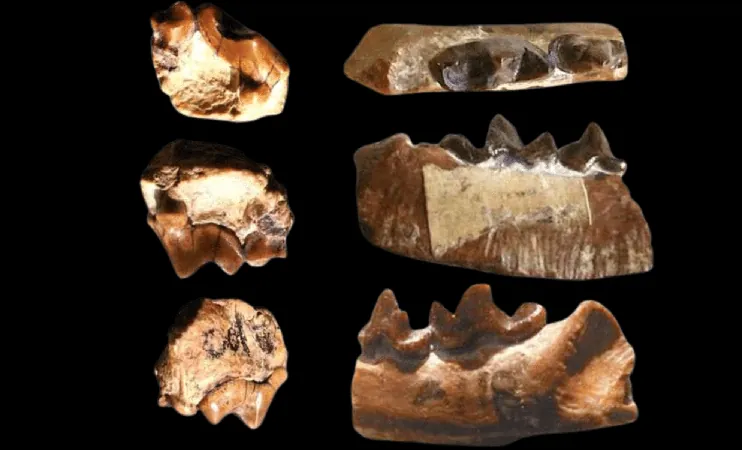
New Fossil Discovery in the Himalayas Uncovers Secrets of Ancient Carnivorous Mammals!
2025-04-03
Author: Ting
New Fossil Discovery in the Himalayas Uncovers Secrets of Ancient Carnivorous Mammals!
A groundbreaking discovery in the Himalayas has captured the attention of scientists and enthusiasts alike! A team of researchers led by Dr. Steven Jasinski from Harrisburg University of Science and Technology has unveiled fascinating fossil specimens that illuminate the world of ancient carnivorous mammals. Their findings, published in the esteemed Journal of Mammalian Evolution, reveal insights into species that roamed the region between 10 and 4 million years ago, challenging our understanding of mammalian evolution.
Unveiling the Siwalik Group: A Treasure Trove of Fossils
The Siwalik Group is a remarkable area stretching across Pakistan, India, Nepal, and Bhutan, known for its impressive fossil record. This region was once a thriving ecosystem, populated by diverse species, including artiodactyls (such as cows and pigs), perissodactyls (like rhinoceroses and horses), proboscideans (the ancestors of modern elephants), and of course, carnivorous mammals, which were the focus of this exciting new research.
Key Discoveries: New Species Unmasked!
Among the newly uncovered fossils is a partial skull, jaws, and teeth, providing a window into the lives of ancient carnivores. Notably, researchers have identified the very first upper-jaw fossil of the rare mustelid Martes lydekkeri, alongside a small fossilized cat. Excitingly, two entirely new species have also been discovered!
The first, Circamustela bhapralensis, is a mustelid that's making history as the first of its kind found in India. This species is believed to have migrated from Europe over 5 million years ago, adjusting to the unique environments of the Himalayan foothills and evolving into smaller, more agile forms akin to modern ferrets.
The second innovation, Vishnuictis plectilodous, is a viverrid boasting a complex tooth structure suggestive of an omnivorous diet. This remarkable species is one of the largest viverrids known, potentially reaching the size of a leopard and weighing over 100 kg!
Revolutionizing Our Understanding of Early Ecosystems
According to Dr. Jasinski, these fossils offer crucial insights into the ecosystems of the base of the Himalayas 5 million years ago. His team’s findings highlight the biodiversity of the region and illustrate how mammalian life dramatically shifted during a period of global cooling. This study also reveals new connections between Europe and Asia during the Late Miocene, hinting at migratory patterns of smaller mammals that may have traversed the continents.
Dr. Sayyed Ghyour Abbas of the University of Sialkot suggests that these connections played a vital role in shaping the dispersal of species, as opportunities arose for mammalian migration during this unique epoch of Earth’s history.
Looking Ahead: Implications for Conservation
By diving into the history of these ancient species, scientists are not only piecing together the puzzle of early carnivorous mammals but are also equipping themselves to make predictions about future ecological shifts. Dr. Jasinski emphasizes, "Our study of the past is essential for predicting our world’s future." As we face unprecedented climate change today, this research could shed light on how modern ecosystems will adapt, offering hope for conservation strategies in the face of environmental challenges.
With these remarkable discoveries, the Himalayas continue to be a source of endless intrigue and inspiration, reminding us of the intricate tapestry of life that has existed long before us and urging us to protect the diverse ecosystems that thrive today!



 Brasil (PT)
Brasil (PT)
 Canada (EN)
Canada (EN)
 Chile (ES)
Chile (ES)
 Česko (CS)
Česko (CS)
 대한민국 (KO)
대한민국 (KO)
 España (ES)
España (ES)
 France (FR)
France (FR)
 Hong Kong (EN)
Hong Kong (EN)
 Italia (IT)
Italia (IT)
 日本 (JA)
日本 (JA)
 Magyarország (HU)
Magyarország (HU)
 Norge (NO)
Norge (NO)
 Polska (PL)
Polska (PL)
 Schweiz (DE)
Schweiz (DE)
 Singapore (EN)
Singapore (EN)
 Sverige (SV)
Sverige (SV)
 Suomi (FI)
Suomi (FI)
 Türkiye (TR)
Türkiye (TR)
 الإمارات العربية المتحدة (AR)
الإمارات العربية المتحدة (AR)